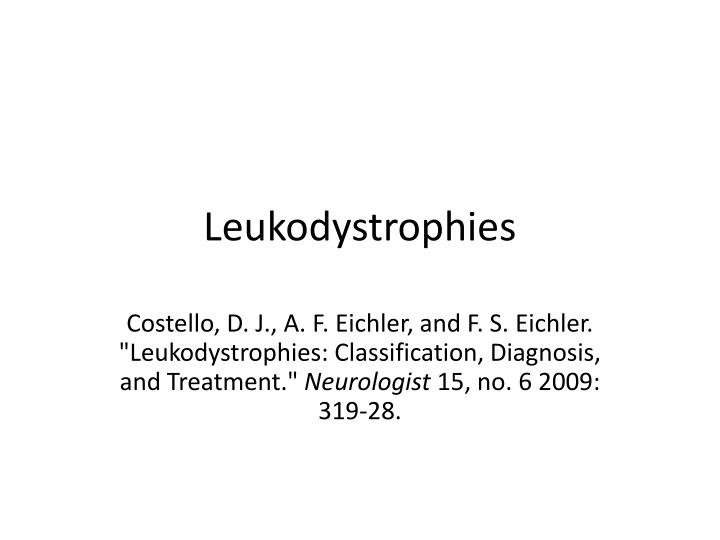
Leukodystrophies: Classification, Diagnosis, and Treatment
Learn about the classification, diagnosis, and treatment of leukodystrophies, including childhood and adult onset symptoms, characteristic imaging findings, biochemistry, and specific types like X-linked ALD and Metachromatic Leukodystrophy. Early recognition and appropriate therapy can help manage these under recognized conditions efficiently.
Download Presentation

Please find below an Image/Link to download the presentation.
The content on the website is provided AS IS for your information and personal use only. It may not be sold, licensed, or shared on other websites without obtaining consent from the author. If you encounter any issues during the download, it is possible that the publisher has removed the file from their server.
You are allowed to download the files provided on this website for personal or commercial use, subject to the condition that they are used lawfully. All files are the property of their respective owners.
The content on the website is provided AS IS for your information and personal use only. It may not be sold, licensed, or shared on other websites without obtaining consent from the author.
E N D
Presentation Transcript
Leukodystrophies Costello, D. J., A. F. Eichler, and F. S. Eichler. "Leukodystrophies: Classification, Diagnosis, and Treatment." Neurologist 15, no. 6 2009: 319-28.
Leukodystrophies Under recognized and frequently misdiagnosed. Many with unknown molecular and biochemical abnormalities Not limited to childhood MRI helps define new clinical patterns MRS to detect abnormal metabolites Together their incidence = that of MS Treatment with enzyme replacement and cell therapy
Childhood onset Normal early development followed by insidious progression Subtle cognitive decline Progressive motor loss Some have other clinical signs E.g. adrenal insufficiency DX- Rule out infections and toxins Family history Pattern of white matter involvement on MRI
Adult-onset Progressive neuropsychiatric disease subcortical dementia Particularly MLD Progressive spastic paraparesis
Characteristic Imaging Confluent imaging abnormalities Not multifocal or asymmetric Enhancement only with X-linked adrenoleukodystrophy
Biochemistry Numerous potential errors in membrane synthesis Lipid synthesis Very long chain fatty acids (X-linked ALD) Protein synthesis PLP (Pelizaeus-Merzbacher) Gap junctions (PMLD) DNA repair
X-linked ALD Several phenotypes Female carriers can have progressive myelopathy Defect in ABCD1 Peroxisome membrane transporter Acyl-CoA esters into peroxisome Immune mediated destruction of myelin Therapy Exogenous steroids Dietary restriction of VLCFA (+ Lorenzo s oil) Bone Marrow transplant (if early)
Metachromatic Leukodystrophy Autosomal recessive Lysosomal arylsulfatase A (ARSA) deficiency Measured in leukocytes High urinary sulfatides Toxic accumulation and oligodendroglia death 3 clinical phenotypes Late infantile, juvenile, adult Therapy Bone marrow transplant Delays onset and progression
Globoid Cell Leukodystrophy (Krabbe Disease) Cerebroside -galactocerebrosidase deficiency Lysosomal enzyme Substrate accumulation Galactosylceramide accumulates in macrophages Therapy M transplant and enzyme replacement ?effectiveness
Vanishing White Matter Disease Occurs in first years of life Short survival Mutations in eIF2B Eukaryotic initiation factor Why just white matter and ovary damage?
Alexander disease Mutation in GFAP gene Induces stress response in astorcytes Death within 10 years
Canavan Disease Aspartoacylase (ASPA) Elevation of NAA ASPA cleaves NAA to acetate and aspartate Aspartate necessary for myelin synthesis
Hereditary Diffuse Leukoencephalopathy with Spheroids Adults CSF receptor deficiency
Pelizaeus-Merzbacher Disease X-linked mutation in PLP1 Failure to form myelin Versus PM-like disease Autosomal recessive Mutation in gap junction protein 12 (GJA12)
Aicardi-Goutieres Syndrome Genetically heterogeneous 5 subtypes Autosomal recessive Subtypes 1-4 Errors in nuclease genes Subtype 5 TREX1 mutation DNA repair
